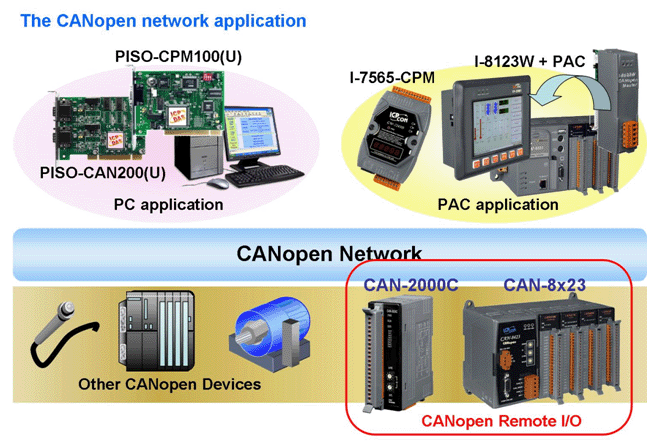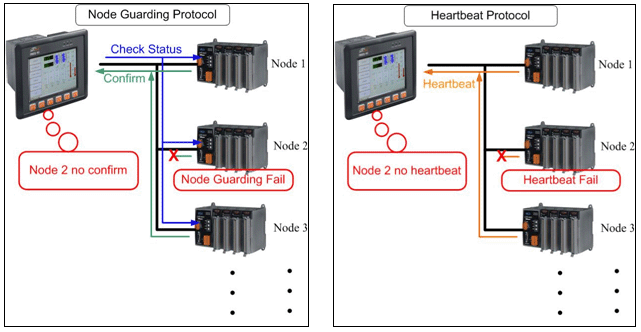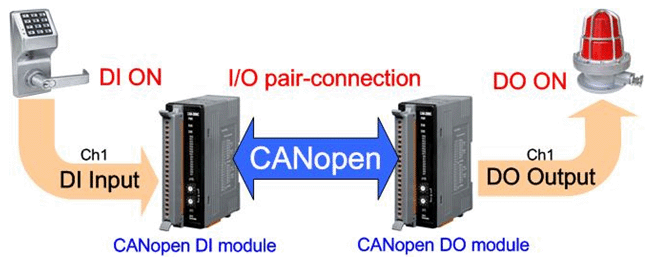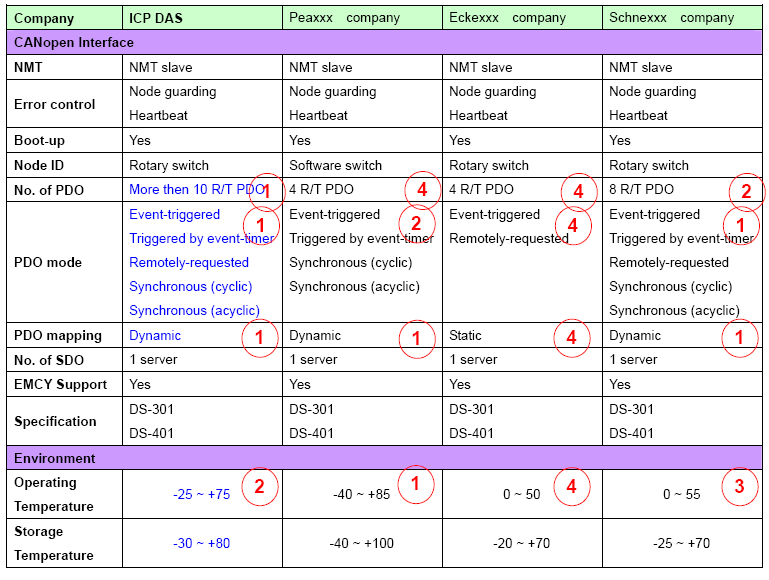|
|
|
|
|
CANopen Remote I/O Application Solutions |
|
|
|
|
|
 |
|
|
|
|
|
ICP DAS has announced several different solutions for the CANopen remote I/O, such as the CAN-8123, CAN-8223, CAN-8423 and CAN-2000C series products. In order to progress in the efficiency of the CANopen network security and approach to the trend of the market, the Heartbeat functionality which is more efficient than Node Guarding functionality is included in these CANopen remote I/O. It can be used for not only detecting the status of the CANopen slaves in time but decreasing the bus loading for the CANopen network. Besides, the CANopen remote I/O also provides the exclusive function, the Digital I/O Pair-connection function. By the configuration the rotary switch, the CANopen DI slave can info any change of the DI status to any other CANopen DO slave through the CANopen network, and then these CANopen DO slaves will modify the DO outputs according to the received DI status. These features greatly improve the performance and flexibility for the CANopen network system. |
|
|
|
|
|
CANopen Remote I/O Features |
|
|
| CANopen Features |
CAN-8x23 Series |
CAN-2000C Series |
| NMT |
Slave |
| Error Control |
Node Guarding protocol/Heartbeat Consumer |
| No. of PDOs |
16 RxPDO, 16 TxPDO |
10 RxPDO, 10 TxPDO |
| PDO Modes |
Event Triggered, Remotely requested, Cyclic and acyclic SYNC |
| PDO Mapping |
Dynamic |
| No. of SDOs |
1 server, 0 client |
| Emergency Message |
Yes |
| CANopen Version |
DS-301 v4.02 |
| Device Profile |
DSP-401 v2.1 |
| Specification |
ISO-11898-2, CAN 2.0A and CAN 2.0B |
Baud Rate (bps)
Setting by Rotary Switch |
10 k, 20 k, 50 k, 125 k, 250 k, 500 k, 800 k, and 1 M |
Node ID
Setting by Rotary Switch |
1 ~ 99 |
| Terminator Resistor |
Jumper for 120 £[ terminator resistor |
Switch for 120 £[ terminator resistor |
| Connector |
5-pin screwed terminal block
(CAN_GND, CAN_L, CAN_SHLD, CAN_H, CAN_V+) |
| EDS file |
Yes |
|
|
|
|
|
|
Protection Mechanism |
|
|
 |
|
|
|
|
|
Digital I/O Pair-connection |
|
|
 |
|
|
ICP DAS provides various solutions for CANopen Masters such as embedded controller, PCI and PCIe boards, PCI 104 boards, and USB interface modules. You can quickly build a CANopen-based network system to approach the different requirements. For these CANopen masters, several free software of CANopen Master are given such as CAN Utility, CPM Utility, LabVIEW driver, CANopen master library and so on. These are helpful to construct your CANopen network systems faster and easier. |
|
|
|
|
|
CANopen Remote I/O Products List |
|
|
| CANopen Slave Series |
Product Description |
 |
CAN-8x23 |
CANopen I/O Expansion Unit
(Support I-8000 and I-87k series I/O modules) |
| CAN-8123: 1 I/O expansion slot |
| CAN-8223: 2 I/O expansion slot |
| CAN-8423: 4 I/O expansion slot |
 |
CAN-2000C
Series |
CANopen Remote I/O Module |
| CAN-2015C: 8-channel RTD Input Module (available soon) |
| CAN-2017C: 8-channel 14-bit Analog Input Module (available soon) |
| CAN-2018C: 8-channel Thermocouple Input Module (available soon) |
| CAN-2024C: 4-channel 14-bit Analog Output Module |
| CAN-2053C: 16-channel Isolated Digital Input Module |
| CAN-2054C: 8-channel DI and 8-channel DO Module |
| CAN-2057C: 16-channel Isolated Digital Output Module |
| CAN-2088C: 8-channel PWM and 8-channel DI/Counter Module |
|
|
|
|
|
|
The advantage of using CANopen remote I/O is the Event-trigger and Event-timer mechanisms. Based on these features, CANopen remote I/O can send the I/O states to the master automatically. You don¡¦t worry about the problems of the message collision and the bigger reaction time. In order to be familiar with the advantages and product features of the ICP DAS CANopen remote I/O, Here is a comparison table of the CANopen remote I/O. The number in the red circle indicates the best order of the characteristics on each row. |
|
|
|
|
|
CANopen remote I/O comparison table |
|
|
 |
|
|
|
|
|
|
 |
back |
|
| |
|
|
|
|






